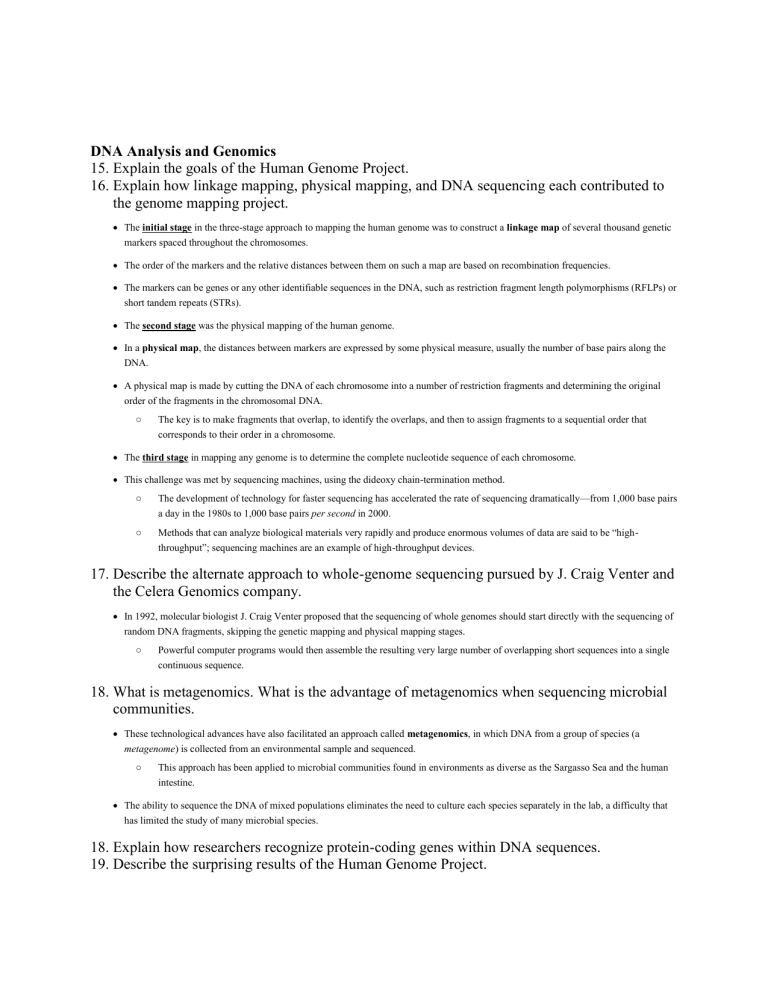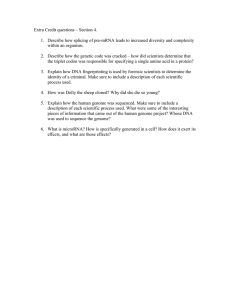
DNA Analysis and Genomics 15. Explain the goals of the Human Genome Project. 16. Explain how linkage mapping, physical mapping, and DNA sequencing each contributed to the genome mapping project. The initial stage in the three-stage approach to mapping the human genome was to construct a linkage map of several thousand genetic markers spaced throughout the chromosomes. The order of the markers and the relative distances between them on such a map are based on recombination frequencies. The markers can be genes or any other identifiable sequences in the DNA, such as restriction fragment length polymorphisms (RFLPs) or short tandem repeats (STRs). The second stage was the physical mapping of the human genome. In a physical map, the distances between markers are expressed by some physical measure, usually the number of base pairs along the DNA. A physical map is made by cutting the DNA of each chromosome into a number of restriction fragments and determining the original order of the fragments in the chromosomal DNA. ○ The key is to make fragments that overlap, to identify the overlaps, and then to assign fragments to a sequential order that corresponds to their order in a chromosome. The third stage in mapping any genome is to determine the complete nucleotide sequence of each chromosome. This challenge was met by sequencing machines, using the dideoxy chain-termination method. ○ The development of technology for faster sequencing has accelerated the rate of sequencing dramatically—from 1,000 base pairs a day in the 1980s to 1,000 base pairs per second in 2000. ○ Methods that can analyze biological materials very rapidly and produce enormous volumes of data are said to be “highthroughput”; sequencing machines are an example of high-throughput devices. 17. Describe the alternate approach to whole-genome sequencing pursued by J. Craig Venter and the Celera Genomics company. In 1992, molecular biologist J. Craig Venter proposed that the sequencing of whole genomes should start directly with the sequencing of random DNA fragments, skipping the genetic mapping and physical mapping stages. ○ Powerful computer programs would then assemble the resulting very large number of overlapping short sequences into a single continuous sequence. 18. What is metagenomics. What is the advantage of metagenomics when sequencing microbial communities. These technological advances have also facilitated an approach called metagenomics, in which DNA from a group of species (a metagenome) is collected from an environmental sample and sequenced. ○ This approach has been applied to microbial communities found in environments as diverse as the Sargasso Sea and the human intestine. The ability to sequence the DNA of mixed populations eliminates the need to culture each species separately in the lab, a difficulty that has limited the study of many microbial species. 18. Explain how researchers recognize protein-coding genes within DNA sequences. 19. Describe the surprising results of the Human Genome Project. 20. Explain how the vertebrate genome, including that of humans, generates greater diversity than the genomes of invertebrate organisms. 21. Explain how in vitro mutagenesis and RNA interference help researchers to discover the functions of some genes. 22. Explain the purposes of gene expression studies. Describe the use of DNA microarray assays and explain how they facilitate such studies. 23. Define and compare the fields of proteomics and genomics. 24. Explain the significance of single nucleotide polymorphisms in the study of the human evolution. Genome Organization at the DNA Level 24. Describe the structure and functions of the portions of eukaryotic DNA that do not encode protein or RNA. 25. Distinguish between transposons and retrotransposons. 26. Describe the structure and location of Alu elements in primate genomes. 27. Describe the structure and possible function of simple sequence DNA. 28. Using the genes for rRNA as an example, explain how multigene families of identical genes can be advantageous for a cell. 29. Using a-globin and b-globin genes as examples, describe how multigene families of nonidentical genes may have evolved. 30. Define pseudogenes. Explain how such genes may have evolved. 31. Describe the hypothesis for the evolution of a-lactalbumin from an ancestral lysozyme gene. 32. Explain how exon shuffling could lead to the formation of new proteins with novel functions. 33. Describe how transposition of an Alu element may allow the formation of new genetic combinations while retaining gene function. Student Misconceptions 1. Students may have difficulty understanding the significance of the genes for antibiotic resistance and sugar metabolism in the bacterial plasmid used in gene cloning. Take students through the procedure step-by-step, pointing out the phenotypic differences between bacteria with and without the plasmid and between bacteria with recombinant and nonrecombinant plasmids. 2. The Human Genome Project has changed our understanding of the evolutionary relationships between living organisms and has provided surprising insights into the nature of the human genome. First-year students may think of biology as a body of well-established facts to be learned, not recognizing the extent to which our knowledge is incomplete. Teaching students about the recent findings that have emerged from the Human Genome Project provides an excellent opportunity to point out how our understanding of life has changed and continues to change. 3. The ongoing debate over the risks and benefits of GM organisms can be used to engage and educate students. Students can explore websites and read primary articles to obtain information about public views and scientific evidence on this controversial topic. Student Misconceptions 1. Students may have difficulty visualizing the different levels of DNA packing in eukaryotic cells. Use visual aids—models or a series of images with 3D representations of DNA—to assist students in understanding how the different levels of packing relate to one another. 2. Students may find it hard to grasp the idea of epigenetic inheritance. They may not understand how modifications to the chromosome that do not alter the sequence of bases can still be passed on to subsequent generations of offspring. Explaining some of the fascinating examples of epigenetic inheritance—including the effects of imprinting in human development—may motivate students to gain a clearer understanding of this concept. 3. Students may find the large number of control points regulating eukaryotic gene expression bewildering. It is important to remind them of the significance of these mechanisms in allowing exquisite control of gene expression during development and in changing environments. 4. The significance of the large number of transposable elements in eukaryotic genomes and the contribution of these elements to the evolution of eukaryotic genomes are difficult concepts for students to master.


